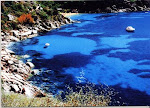The trash vortex
A tiny fraction of the plastic waste in the oceans being collected from a beach. Plastic waste kills many marine animals when they mistake plastic for food.
Take a walk along any beach anywhere in the world and washed ashore will be many polythene plastic bags, bottles and containers, plastic drums, expanded polystyrene packing, polyurethane foam pieces, pieces of polypropylene fishing net and discarded lengths of rope. Together with traffic cones, disposable lighters, vehicle tyres and toothbrushes, these items have been casually thrown away on land and at sea and have been carried ashore by wind and tide.
These larger items are the visible signs of a much larger problem. These big items do not degrade like natural materials. At sea and on shore under the influence of sunlight, wave action and mechanical abrasion they simply break down slowly into ever smaller particles.
A single one litre drinks bottle could break down into enough small fragments to put one on every mile of beach in the entire world. These smaller particles are joined by the small pellets of plastic which are the form in which many new plastics are marketed and which can be lost at sea by the drumload or even a whole container load. These modern day “marine tumbleweeds” have been thrown into sharp focus, not only by the huge quantities removed from beaches by dedicated volunteers, but by the fact that they have been found to accumulate in sea areas where winds and currents are weak.
The “Eastern Garbage Patch”
The North Pacific sub-tropical gyre covers a large area of the Pacific in which the water circulates clockwise in a slow spiral. Winds are light. The currents tend to force any floating material into the low energy central area of the gyre. There are few islands on which the floating material can beach. So it stays there in the gyre, in astounding quantities estimated at six kilos of plastic for every kilo of naturally occurring plankton. The equivalent of an area the size of Texas swirling slowly around like a clock. This gyre has also been dubbed “the Asian Trash Trail” the “Trash Vortex” or the “Eastern Garbage Patch”.
This perhaps wouldn’t be too much of a problem if the plastic had no ill effects. The larger items, however, are consumed by seabirds and other animals which mistake them for prey. Many seabirds and their chicks have been found dead, their stomachs filled with medium sized plastic items such as bottle tops, lighters and balloons. A turtle found dead in Hawaii had over a thousand pieces of plastic in its stomach and intestines. It has been estimated that over a million sea-birds and one hundred thousand marine mammals and sea turtles are killed each year by ingestion of plastics or entanglement.
Animals can become entangled in discarded netting and line. Even tiny jelly-fish like creatures become entangled in lengths of plastic filament, or eat the small plastic particles floating in the water.
Chemical sponge
There is a sinister twist to all this as well. The plastics can act as a sort of “chemical sponge”. They can concentrate many of the most damaging of the pollutants found in the worlds oceans: the persistent organic pollutants (POPs). So any animal eating these pieces of plastic debris will also be taking in highly toxic pollutants.
The North Pacific gyre is one of five major ocean gyres and it is possible that this Trash Vortex problem is one which is present in other oceans as well. The Sargasso Sea is a well known slow circulation area in the Atlantic, and research there has also demonstrated high concentrations of plastic particles present in the water.



Keine Kommentare:
Kommentar veröffentlichen